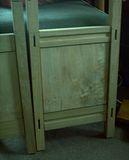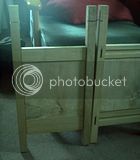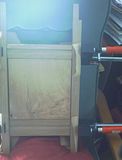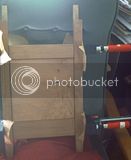so after the rant yesterday, moved the router table out of the way,
massaged the damage within the longs slots with some ronseal filler.
says antique pine and mid oak, well obviously these guys and i have a different view on colours

still it is in the slots and can't be seen outside and will not i think affect the staining or varnish, depending upon what i use :roll: think i am looking for light to mid colour.
used the bosch ros on all the bits except the legs. attach the vacuum and turn on before use, the machine sticks to the wood 8) only problem is that you end up after an hour or so, with tingling arms :?
used 400 grit since all i was looking for was regaining the light colour of the wood, and ending up with a general matching of all the oak.
so on the router, i did the slots in the legs, and also in the other cross rails because i was getting lazy :twisted:
i also kind of fielded the floating panels. but since i wanted it to look almost smooth, i used a bit i think they call a sinking bit since it has a wide flat bottom and slight curve on the edges. of course you are stuck with the distance between your fence and the edge of the rotating cutter :?
more of that later.
then i test fitted it all, and discovered that of course,

due to the previously complained about problems with depth setting, the floaters were too long for the slots in the cross rails.
so out with the mitre board and the number 7, really nice long shavings,
then the next problem, the fielded part hits, so i then got out my veritas
large shoulder plane and massaged the gap. oh what a loverly plane, and how easy with a sharp blade. works really well with end grain too, thanks rob and the guys, that moveable handle at the rear is really useful.
so the big question is i am right i should worry more about cross ways movement of the wood rather than vertical shouldn't I???

given that this is about 300 wide, how much movement should i allow for in the lime end panel???? seems to slop about so should i guess be ok when the heating comes and goes.
i have also cut the base lines for the top tenons on the legs, and now have to lay out the lines to make the lower end of the legs slightly tapered on all 4 sides. i intend to hand plane so that should be fun :? am only looking for a small distance on each side.
the plan is to have a shallow outside taper on the two outside edges, then a slightly bigger taper on the inside. hopefully that will leave enough strength but reduce the heaviness at the bottom.
i have decided during construction not to put a drawer unit and door in between the legs cause as i make it it seems that that would make the whole unit too heavy in look and not necessarily add to the usefulness.
so i will have two mdf 12mm oak faced solid shelves instead.
so i am almost ready for glue up of the end panels and legs either tonight or tomorrow. need to put some clear acrylic varnish on the end grain of the floating panel just to ensure.
final jobs on these bits are complete the upper tenons, which are only on two edges to allow the greatest area for glueing. tapering the bottoms, and then sanding the legs, and gluing up, ensuring that the top cross rails line up with the long rails so the whole is square and the shelves are level :roll:
anyway latest photos. i think they show why i wanted to use the lime on the end panels.
[/url]




[/img]
so what you have is the inside of one end and the outside of the other, to show i have made both ends of the table :?
so the saw cuts at the top are for the tenons, and luckily, as you can see, the units look pretty similar.
more importantly you can see why i wanted to put the lime in something which would highlight it, and that is also why i decided not to put the box in the middle :?
so with any luck, i will get most of it done before next weekend, since now it is the really tricky bit of gluing up and squaring up

:twisted: :roll:
so a round up, hand planed all the wood, including the end panels after colin c had bandsawn them for me. (but did run the legs through the p/t because i needed them to be exactly the same

)
used the plough for one set of grooves, but unable to do so on the legs so i did that on the router table, and then one more set of grooves, and then fielding on the end panels.
finally used the mitre plane and shoulder plane to ensure the end panels fitted well. then the ros for smoothing.

so two shelves to be cut later in the week, and of course hand cut the corners since i have not grooved across the legs at the intersection. so will i need to make some mouldings i hope not :roll:
i think the shadow line around the end panel looks better than adding moulding. and you will notice that the end panel overlaps the slot slightly to hide any errors :roll:
must get my scraper plane working properly :?
paul :wink:










































